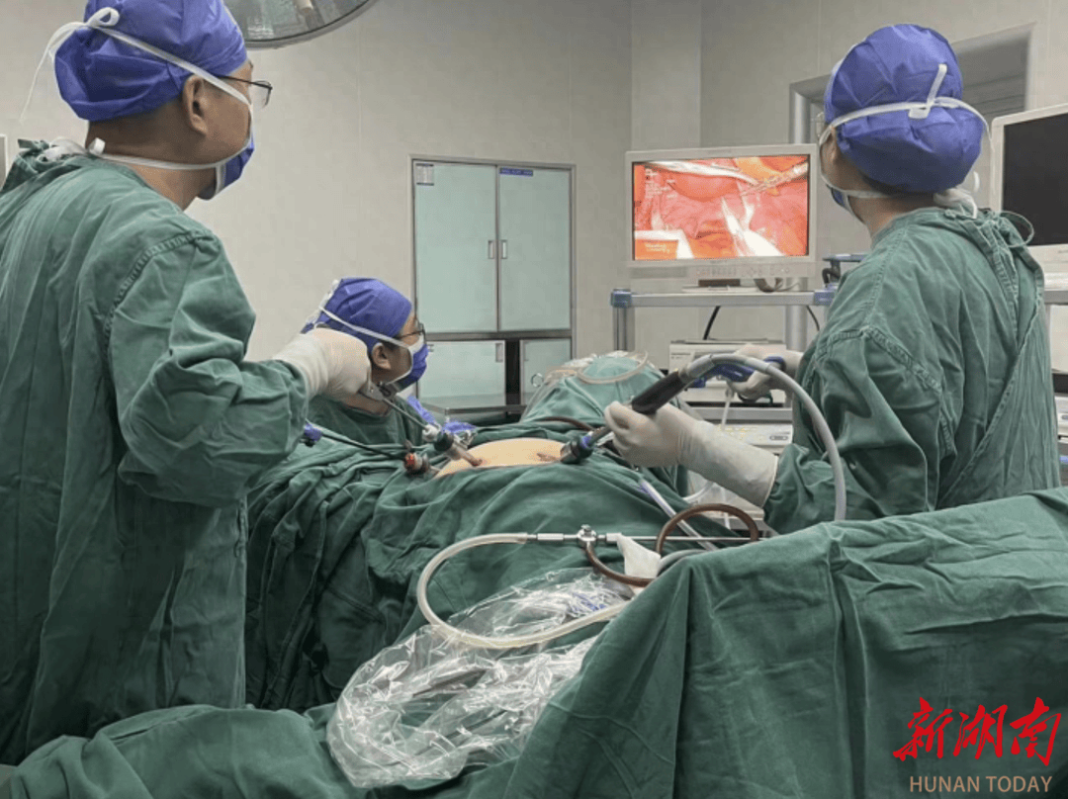The Public Health News · New Hunan Client, August 10 (Correspondent: Wen/Zhang Bei, Zhou Runmei; Photo: Zhan Shenghong) On August 7, the team from the Obstetrics and Gynecology Department of Xiangtan Maternal and Child Health Hospital successfully completed the first laparoscopic cervical cerclage surgery in Xiangtan City, bringing hope to patients with cervical incompetence leading to miscarriage.
(Experts from the Obstetrics and Gynecology Department of Xiangtan Maternal and Child Health Hospital performing surgery for the patient)
Ms. Ye had been married for many years without conceiving. After much effort, she finally had twins through in vitro fertilization, but unfortunately suffered a natural miscarriage at over 22 weeks due to cervical incompetence.
After recovering, Ms. Ye actively prepared for another pregnancy. She and her family were very worried that another pregnancy would again lead to miscarriage due to cervical incompetence. In her anxious state, she was recommended by a friend to seek help from Dr. Zhan Shenghong, an associate chief physician at the Obstetrics and Gynecology Department of Xiangtan Maternal and Child Health Hospital. Dr. Zhan conducted a careful examination, helped instill confidence in the patient, and tailored a treatment plan for her — laparoscopic cervical cerclage. This procedure is minimally invasive, involves less bleeding, has a quick recovery time, and a high pregnancy rate after surgery. Post-surgery, Ms. Ye recovered quickly and looked forward to her “good fortune”!
Health Mini Science
What is cervical incompetence?
Cervical incompetence refers to the inability of the cervix to maintain a pregnancy leading to miscarriage or preterm birth without uterine contractions, due to anatomical or functional defects. It is also known as cervical incompetence, cervical insufficiency, or cervical weakness. Cervical incompetence is one of the main causes of mid-pregnancy loss and preterm birth, and cervical cerclage is currently the only effective surgical option for cervical incompetence.
What are the surgical approaches for cervical cerclage?
There are mainly three surgical approaches: transvaginal, laparoscopic, and open surgery. Among them, laparoscopic cerclage involves stitching the cervix in a circular fashion through the laparoscope, tightening the cervix, and has advantages such as minimal trauma, less bleeding, quick recovery, and good effectiveness.
Advantages of pre-pregnancy laparoscopic cerclage
The location of the cerclage is high, resulting in minimal trauma, less bleeding, a quick recovery, and a high success rate. It can avoid cervical cerclage after pregnancy, reducing cervical irritation and lowering the risk of miscarriage.
Who is suitable for pre-pregnancy cerclage?
Patients with failed transvaginal cerclage, deep cervical lacerations, shortened cervix, or hard cervical scarring, as well as those who have undergone extensive cervical resection, are unsuitable for transvaginal cerclage. The best timing for pre-pregnancy cerclage is 3 to 6 months before planned pregnancy, about 3 to 5 days after menstruation.
What should be noted after surgery? How long before one can try for pregnancy?
After surgery, ample rest and attention to hygiene are necessary. During the conception period, avoid staying up late and maintain a positive mood. Two months after surgery, one can start preparing for pregnancy under a doctor’s guidance, and it is possible to conceive more than once after a single cerclage procedure.


